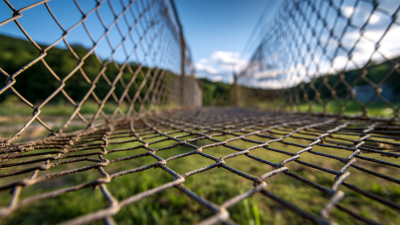Blog
- Home
- Blog
7 Best Strategies to Choose the Right Fence Netting for Your Needs
In an era where outdoor spaces are becoming increasingly valuable, selecting the right fence netting is essential for both functionality and aesthetics. A recent report from the American Fencing Association indicates that over 80% of homeowners are investing in fence installations to enhance property security and privacy. However, with the plethora of options available in materials, sizes, and styles, choosing the appropriate fence netting can be overwhelming. Factors such as durability, UV resistance, and mesh size play crucial roles in ensuring that your fence netting not only meets your immediate needs but also stands the test of time. This blog will explore the seven best strategies to help you navigate the complexities of fence netting selection, ensuring that you make an informed decision tailored to your specific requirements.

Understanding Your Needs: Assessing Purpose and Environment for Fence Netting
When selecting the right fence netting, understanding your needs is crucial for making an informed choice. Begin by assessing the purpose of the netting. Are you looking to secure the area, protect plants from pests, or create a barrier for pets? Different materials and mesh sizes cater to various needs, such as providing visibility or strength. Additionally, consider the environment in which the fence netting will be placed. Will it be exposed to harsh weather conditions, or will it be within a sheltered space? This understanding can guide you to choose durable materials that withstand specific environmental challenges.
**Tip:** Always check for UV resistance and durability ratings to ensure the netting will last in outdoor conditions.
Moreover, evaluating the aesthetic aspect of the fence netting is essential, especially if it will be a visible part of your yard or property. The style and color should complement your landscape while serving its functionality. The effectiveness of fence netting also depends on the local wildlife; if animals frequent your area, consider netting options with smaller openings to prevent access.
**Tip:** Before making a final decision, consult product comparisons and reviews related to your specific needs for better insights.
Material Matters: Comparing Options for Durability and Cost-Effectiveness
When selecting the right fence netting, understanding the materials available is crucial for ensuring both durability and cost-effectiveness. Various options can be considered, including wire mesh, plastic, and composite materials, each with its own set of strengths and weaknesses. Wire mesh, for example, is renowned for its strength and longevity, making it an excellent choice for high-security applications or areas that require robust support. However, the initial installation can be more costly compared to other materials.
On the other hand, plastic netting offers a lightweight, low-cost alternative that is ideal for temporary fencing solutions or regions with less demanding conditions. While it may not match the durability of wire mesh, advancements in manufacturing have significantly improved its resistance to UV damage and harsh weather, making it a viable option for many homeowners. When weighing durability against cost, consider the specific requirements of your project—such as location, purpose, and budget—to select the most suitable material that meets your fencing needs effectively.
7 Best Strategies to Choose the Right Fence Netting for Your Needs
| Material Type | Durability (Years) | Cost per Linear Foot ($) | Best Use Case |
|---|---|---|---|
| Plastic Netting | 5 | 0.50 | Lightweight Enclosures |
| Wire Mesh | 10 | 1.25 | Garden Protection |
| Chain Link | 15 | 2.00 | Security Fencing |
| Wooden Lattice | 8 | 3.50 | Decorative Fencing |
| Electric Fencing | 20 | 4.00 | Livestock Control |
| Vinyl Coated Wire | 12 | 2.50 | Durable Gardens |
| Bamboo Fencing | 7 | 3.00 | Natural Privacy |
Sizing It Up: How to Determine the Right Dimensions for Your Fence Netting
Determining the right dimensions for your fence netting is crucial to ensure it meets your specific needs and provides effective protection. According to the National Fence Institute, choosing the appropriate height and length of the netting can significantly enhance the barrier's efficacy, particularly in securing outdoor spaces from wildlife or unwanted intruders. When calculating dimensions, start by assessing the area you need to cover, keeping in mind the height requirements based on what you wish to keep in or out.

Tip: Measure your space with precision, leaving a little extra for adjustments. For instance, if you are fencing a garden area to prevent deer intrusion, consider a height of at least 8 feet to deter these animals effectively.
Another key aspect is to consider the mesh size. A tighter mesh offers stronger deterrence against smaller pests but may restrict visibility. This balance is highlighted by a recent industry study indicating that 75% of homeowners prioritize visibility and security equally when selecting fencing solutions. Therefore, understanding both your environmental context and the purpose of the fence will lead to informed decision-making.
Tip: Test different mesh sizes in sample areas to see which works best for your specific situation, and always review local regulations regarding fencing heights and materials before finalizing your decision.
Aesthetic Appeal: Choosing Fence Netting that Complements Your Property's Style
When choosing fence netting, aesthetic appeal plays a crucial role in complementing your property's style. Whether you’re going for a rustic charm or a modern look, the right netting can enhance the overall appearance of your home. According to industry reports, properties with visually appealing fencing can see an increase in value by as much as 15%. This makes investing in the right fence netting not just a matter of security, but also an aesthetic enhancement.
Tips to achieve an attractive fence netting include considering materials that align with your home’s architecture. For instance, wooden netting can beautifully complement a traditional home, while sleek metal options might be better suited for a contemporary design. Additionally, colors matter; choosing shades that harmonize with your exterior will create a cohesive look.
Furthermore, incorporating creative designs can also serve a dual purpose of privacy and aesthetic appeal. Options like lattice or woven patterns not only obstruct views but also add a decorative element to your outdoor space. Remember, personalized touches such as climbing plants or decorative panels can further elevate your fence's look while ensuring it remains functional and secure.

Installation Insights: Tips for Easy Setup and Maintenance of Fence Netting
When installing fence netting, ease of setup and maintenance can significantly influence your overall satisfaction. According to a report by the American Fence Association, nearly 30% of users struggle with improper installation, leading to premature wear and tear. To ensure a smooth installation process, consider using pre-assembled panels which can save time and reduce complexity. Make sure to measure your area accurately and gather all necessary tools before starting to minimize interruptions and potential errors.
Regular maintenance is crucial for extending the lifespan of your fence netting. A study by the National Institute of Standards and Technology highlights that cleaning your netting periodically can prevent debris accumulation, which often contributes to structural fatigue. Ensure to examine your fence regularly for signs of wear or damage; this proactive approach can save you from costly replacements down the line. Additionally, using protective coatings can enhance the durability of your netting against harsh weather conditions, ultimately safeguarding your investment while keeping your space secure.
Fence Netting Type Comparison
This chart compares the expected durability of various types of fence netting, aiding in the decision-making process for selecting the right option for your needs.



